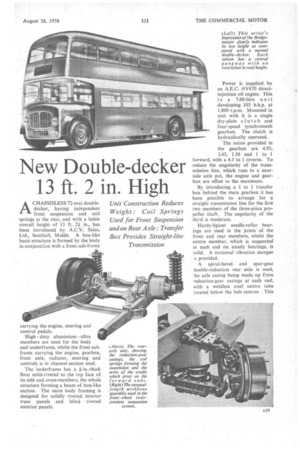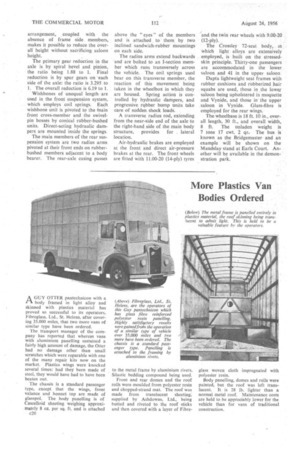New Double-decker 13 ft. 2 in. High
Page 57

Page 58

If you've noticed an error in this article please click here to report it so we can fix it.
CHASSISLESS 72-seat double decker, having independent front suspension and coil springs at the rear, and with a laden overall height of 13 ft. 2-k in., has been introduced by A.C.V. Sales, Ltd., Southall, Middx. A box-like basic .structure is formed by the body in conjunction with a front sub-frame carrying the engine, steering and control pedals.
High duty aluminium alloy members are used for the body and underframe, whilst the front subframe carrying the engine, gearbox, front axle, radiator, steering and controls is in channel-section steel.
The underframe has a fin.-thick floor solid-riveted to the top face of its side and cross-members, the whole structure forming a beam of box-like section. The main body framing is designed for solidly riveted interior truss panels and blind riveted exterior panels. Power is supplied by an A.E.C. AV470 directinjection oil engine. This i s a 7.68-litre unit developing 103 b.h.p. at 1,800 r.p.m. Mounted in unit with it is a single dry-plate clutch and four-speed synchromesh gearbox. The clutch is hydraulically operated.
The ratios provided in the gearbox are 4.93, 2.65, 1.56 and 1 to 1 forward, with a 4.3 to 1 reverse. To reduce the angularity of the transmission line, which runs to a nearside axle pot, the engine and gearbox are offset to the maximum.
By introducing a 1 to 1 transfer box behind the main gearbox it has been possible to arrange for a straight transmission line for the first two members of the three-piece propeller shaft. The angularity of the third is moderate.
Hardy-Spicer needle-roller bear ings are used in the joints of the front and rear members, whilst the centre member, which is supported at each end on steady bearings, is solid. A torsional vibration damper s provided.
A spiral-bevel and spur-gear 1ouble-reduction rear axle is used, he axle casing being made up from reduction-gear casings at each end, with a weldless steel centre tube located below the hub centres. This arrangement, coupled with the absence of frame side members, makes it possible to reduce the overall height without sacrificing saloon height.
The primary gear reduction in the axle is by spiral bevel and pinion, the ratio being 1.88 to 1. Final reduction is by spur gears on each side of the axle: the ratio is 3.295 to I. The overall reduction is 6.19 to 1.
Wishbones of unequal length are used in the front suspension system, which employs coil springs. Each wishbone unit is pivoted to the main front cross-member and the swivelpin bosses by conical rubber-bushed units. Direct-acting hydraulic dampers are mounted inside the springs.
The main members of the rear suspension system are two radius arms pivoted at their front ends on rubberbushed members adjacent to a body bearer. The rear-axle casing passes above the " eyes " of the members and is attached to them by two inclined sandwich-rubber mountings on each side.
The radius arms extend backwards 'and are bolted to an I-section member which runs transversely across the vehicle. The coil springs used bear on this transverse member, the reaction of this movement being taken in the wheelbox in which they are housed. Spring action is controlled by hydraulic dampers, and progressive rubber bump units take care of sudden shock loads.
A transverse radius rod, extending from the near-side end of the axle to the right-hand side of the main body structure, provides for lateral location.
Air-hydraulic brakes are employed at the front and direct air-pressure brakes at the rear. The front wheels are fitted with 11.00-20 (14-ply) tyres and the twin rear wheels with 9.00-20 (12-ply).
The Crossley 72-seat body, in which light alloys are extensively employed, is built on the stressedskin principle. Thirty-one passengers are accommodated in the lower saloon and 41 in the upper saloon Dapta lightweight seat frames with rubber cushions and rubberized hair squabs are used, those in the lower saloon being upholstered in moquette and Vynide, and those in the upper saloon in Vynide. Glass-fibre is employed for the rear wings.
The wheelbase is 18 ft. 10 in., overall length, 30 ft., and overall width, 8 ft. The unladen weight is 7 tons 17 cwt. 2 qr. The bus is known as the Bridgemaster and an example will be shown on the Maudslay stand at Earls Court. Another will be available in the demonstration park.












































































































